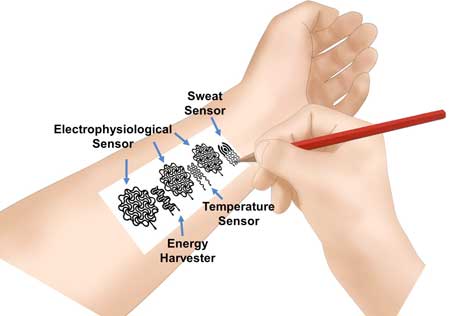Understanding Bioelectronics: The Intersection of Biology and Electronics
Definition: Bioelectronics is an interdisciplinary field that blends biology with electronics, focusing on the development and application of electronic devices and technologies to biology and medicine. It involves the collaborative efforts of scientists, engineers, and medical professionals to explore and manipulate electrical processes in biological systems. This field leads to groundbreaking innovations in medical devices, diagnostics, and treatments, embodying the convergence of different scientific realms for health advancements.

Introduction to Bioelectronics
Bioelectronics combines principles from electrical engineering, physics, chemistry, and biology to understand and harness the electrical aspects of biological systems. It is pivotal in developing technology-driven solutions for healthcare, including medical diagnostics, therapeutic devices, and systems for monitoring physiological processes.
Principles and Technologies
The study of how electrical signals are generated and processed in biological systems is central to bioelectronics. It employs technologies such as biosensors, neural interfaces, and electronic implants to interact with biological systems for monitoring, diagnosis, or therapeutic purposes. These devices require advanced materials and nanoengineering to ensure functionality and biocompatibility within the human body.
Materials in Bioelectronics and the Role of Nanomaterials
The advancement and effectiveness of bioelectronic devices hinge significantly on the materials used in their construction. These materials must not only possess exceptional electrical properties but also be biocompatible, ensuring they can interact safely and effectively with biological systems. The choice of material impacts the device's functionality, durability, and integration with biological tissues.
The integration of conventional materials with nanomaterials in bioelectronics represents a synergistic approach that leverages the strengths of each material type. This integration is driving the field forward, enabling the development of more sophisticated, efficient, and patient-friendly bioelectronic devices. As research in material science and nanotechnology continues to advance, we can expect to see even more innovative applications that push the boundaries of what is possible in bioelectronics.
Conventional Materials
Traditional materials used in bioelectronics include metals such as gold, platinum, and titanium, known for their good electrical conductivity and biocompatibility. Polymers, both natural and synthetic, are also widely used due to their flexibility and ability to be engineered to specific needs. Silicon, a semiconductor, plays a crucial role in microelectronic components of bioelectronic devices, offering a combination of good electrical properties and compatibility with existing microfabrication technologies.
Nanomaterials: Enhancing Bioelectronic Interfaces
Nanomaterials, characterized by their size of less than 100 nanometers in at least one dimension, have emerged as transformative elements in bioelectronics. Their small size and high surface area to volume ratio provide unique electrical, chemical, and mechanical properties that are advantageous for bioelectronic applications. Nanomaterials such as carbon nanotubes, graphene, and metallic nanoparticles (e.g., gold and silver nanoparticles) have been incorporated into sensors, electrodes, and other components of bioelectronic devices.
The application of nanomaterials in bioelectronics has led to enhanced sensitivity and specificity in biosensors, improved electrical stimulation for neural interfaces, and more effective delivery of therapies at the cellular level. For example, graphene's exceptional conductivity and flexibility make it ideal for flexible bioelectronic devices, while carbon nanotubes have been used to create highly sensitive biosensors for detecting biomolecules at low concentrations.
Moreover, nanomaterials have played a pivotal role in developing bioresorbable electronics, where devices are designed to dissolve harmlessly in the body after completing their therapeutic function. This application addresses long-term biocompatibility issues and reduces the need for surgical removal of devices.
Key Applications in Healthcare
Bioelectronics has revolutionized healthcare through:
- Wearable and Implantable Devices: From pacemakers and cochlear implants to wearable fitness trackers monitoring vital signs, these devices showcase the practical applications of bioelectronics.
- Diagnostic Tools: Including biosensors and lab-on-a-chip technologies for the rapid and sensitive detection of diseases, as well as health condition monitoring.
- Therapeutic Technologies: Devices for electrical stimulation in pain management, rehabilitation, and treating neurological disorders are becoming increasingly sophisticated.
Emerging applications such as bioelectronic medicine, which targets electrical signals in the body to treat chronic diseases, and interfaces with the nervous system, are opening new frontiers in medical science. These advancements hold the promise of more personalized and effective treatments for a range of conditions.
Challenges and Future Directions
Bioelectronics faces challenges related to biocompatibility, the long-term stability of implants, and ethical considerations. Research is ongoing to overcome these obstacles, enhance device performance, and explore new applications. The field is rapidly evolving, with a focus on developing non-invasive, precise, and intelligent bioelectronic systems.
Innovations in Bioelectronic Devices
The field has seen recent advancements in materials science, microfabrication, and wireless technology, leading to smaller, more efficient, and less invasive devices. Innovations include flexible electronic skins, bioresorbable electronics, and brain-computer interfaces, which offer new possibilities for treating neurological conditions and beyond.
Impact on Medical Research and Clinical Practice
Bioelectronics is transforming medical research and clinical practice by providing new insights into physiological processes and novel treatment approaches. Its interdisciplinary approach encourages collaboration across scientific and medical fields, leading to rapid advancements and improved health outcomes.
Further Reading
Chemical Reviews, Introduction: Organic Bioelectronics
